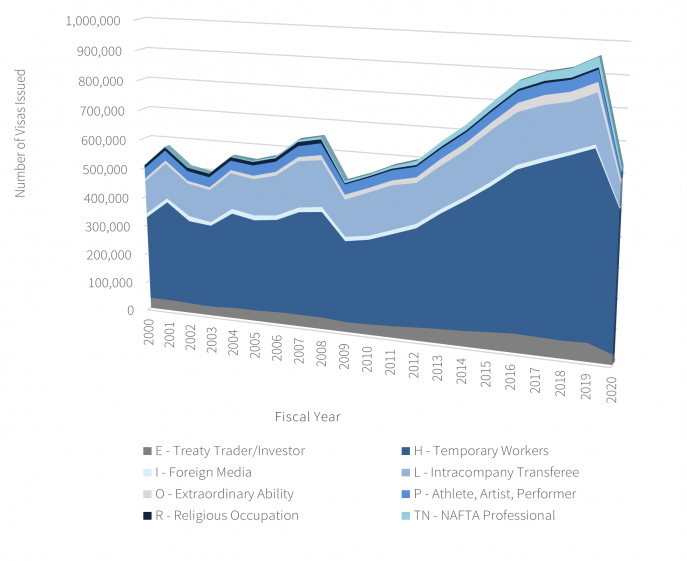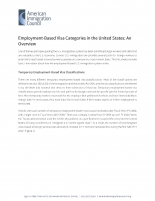- Fact Sheet
Employment-Based Visa Categories in the United States
Published
One of the key principles guiding the U.S. immigration system has been admitting foreign workers with skills that are valuable to the U.S. economy. Current U.S. immigration law provides several paths for foreign workers to enter the United States for employment purposes on a temporary or permanent basis. This fact sheet provides basic information about how the employment-based U.S. immigration system works.
Temporary Employment-Based Visa Classifications
There are many different temporary employment-based visa classifications. Most of the classifications are defined in section 101(a)(15) of the Immigration and Nationality Act (INA), and the visa classifications are referred to by the letter and numeral that denotes their subsection of that law. Temporary employment-based visa classifications permit employers to hire and petition for foreign nationals for specific jobs for limited periods of time. Most temporary workers must work for the employer that petitioned for them and have limited ability to change jobs. In most cases, they must leave the United States if their status expires or if their employment is terminated.
Overall, the total number of temporary employment-based visas issued increased after Fiscal Year (FY) 2000, with a slight peak in Fiscal Years 2007-2008. There was a steady increase from FY 2009 up until FY 2020, when the Trump administration used the COVID-19 pandemic as a justification to suspend the entry into the United States of many noncitizens on immigrant and nonimmigrant visas. As a result, the number of nonimmigrant visas issued at foreign service posts abroad plummeted in FY 2020 and remained low during the first half of FY 2021 (Figure 1).
Figure 1. Nonimmigrant Visas Issued by Select Classifications, FY 2000-2021

Note: Totals include spouses and children of primary beneficiaries.
Source: U.S. Department of State, Report of the Visa Office, 2000-2020, “Classes of Nonimmigrants Issued Visas,” https://travel.state.gov/content/travel/en/legal/visa-law0/visa-statistics/annual-reports.html.
The visa classifications vary in terms of their eligibility requirements, duration, whether they permit workers to bring dependents, and other factors. Table 1 includes information on several of the most common temporary employment-based visa classifications.
Table 1: Characteristics of Common Temporary Employment-Based Visa Classifications
|
|
H-1B |
H-2A |
H-2B |
L-1A & L-1B |
|---|---|---|---|---|
|
Who is eligible? |
Certain foreign professionals in “specialty occupations.” |
Temporary agricultural workers from certain designated countries. |
“Seasonal” non-agricultural temporary workers. |
Certain foreign workers employed by certain entities abroad that are related to U.S. employers, whose services are being sought by their employers in the United States. |
|
Are there any numerical annual limits? |
65,000 per year, plus 20,000 more for foreign professionals with a U.S. master’s or higher degree. |
No annual limit. |
66,000 per year. |
No annual limit. |
|
Duration |
Initially admitted for a period of up to three years; may be extended for a maximum of three additional years. |
Initially admitted for period of approved employment; may be renewed for qualifying employment in increments of one year each for a maximum stay of three years. |
Initially admitted for a period of up to one year; may be renewed twice for a maximum stay of three years. |
Initially admitted for a period of up to three years; may be extended for a maximum of two additional years for an L-1B and four additional years for an L-1A. |
|
Employer requirements |
The employer must attest that employment of the H-1B worker will not adversely affect the wages and working conditions of similarly employed U.S. workers. Employers must comply with wage requirements.
|
The employer must attest that no qualified U.S. workers who can fill the position are available. Employers must comply with recruitment, wage, benefits, housing, transportation, and other requirements. |
The employer must attest that no qualified U.S. workers who can fill the position are available. Employers must comply with wage, housing, transportation, and other requirements. |
No requirements regarding adverse effects, wages, housing, etc. |
|
May the foreign workers bring their spouses and children under 21? |
Yes, spouses and children under 21 may enter on an H-4 visa, and certain spouses are allowed to work. |
Yes, spouses and children under 21 may enter on an H-4 visa but may not work. |
Yes, spouses and children under 21 may enter on an H-4 visa but may not work. |
Yes, spouses and children under 21 may enter on an L-2 visa, and spouses are allowed to work. |
Permanent Employment-Based Immigration
Lawful permanent residency allows a foreign national to work and live lawfully and permanently in the United States. Lawful permanent residents (LPRs) are eligible to apply for nearly all jobs (i.e., jobs not legitimately restricted to U.S. citizens) and can remain in the country even if they are unemployed. Immigrants who acquired lawful permanent resident (LPR) status through employment may apply for U.S. citizenship after five years.
The adjustment of status to permanent residency based on employment generally involves a three-step process:
- First, employers seeking to petition on behalf of foreign workers are commonly required to obtain certification from the Department of Labor (DOL), establishing that there are no U.S. workers available, willing, and qualified to fill the position at a wage that is equal to or greater than the prevailing wage generally paid for that occupation in the geographic area where the position is located.
- Second, the employer is required to petition U.S. Citizenship and Immigration Services (USCIS) for the foreign worker. Immigrants can petition for themselves under limited circumstances.
- Third, a foreign worker who is already in the United States in a temporary visa classification may apply for “adjustment of status” to permanent residence upon the approval of the employer’s petition, if there is a visa number available. If these conditions have been met and the individual is outside the United States, or is in the United States but chooses to apply for an immigrant visa at a U.S. Embassy or Consulate abroad, the individual files an immigrant visa application, which is processed by a U.S. consular officer.
Most foreign nationals who obtain permanent residency are already in the United States. In FY 2019, 79 percent of employment-based LPRs adjusted to LPR status and 21 percent arrived from abroad.
The overall numerical limit for permanent employment-based immigration is 140,000 per year. But this number includes not only the immigrants themselves, but their eligible spouses and minor children as well, meaning that the actual number of employment-based immigrants is less than 140,000 each fiscal year. Moreover, the 140,000 visas are divided among five preference categories, each of which is subject to its own numerical cap (detailed in Table 2).
Table 2: Permanent Employment-Based Preference System
|
Preference Category |
Eligibility |
Yearly Numerical Limit |
|---|---|---|
|
1 |
“Persons of extraordinary ability” in the arts, science, education, business, or athletics; outstanding professors and researchers; multinational managers and executives. |
40,000* or 28.6% |
|
2 |
Members of the professions holding advanced degrees, or persons of exceptional abilities in the arts, science, or business. |
40,000** or 28.6% |
|
3 |
Skilled workers with at least two years of training or experience, professionals with college degrees, or “other” workers for unskilled labor that is not temporary or seasonal. |
40,000*** or 28.6% “Other” unskilled laborers restricted to 5,000 |
|
4 |
Certain “special immigrants” including religious workers, employees of U.S. foreign service posts, translators, former U.S. government employees, and other classes of noncitizens. |
9,940 or 7.1%. |
|
5 |
Persons who will invest $500,000 to $1 million in a job-creating enterprise that employs at least 10 full-time U.S. workers. |
9,940 or 7.1%. |
|
Total Employment-Based Immigrants: |
140,000 for principals and their dependents |
|
*Plus any unused visas from the 4th and 5th preferences
**Plus any unused visas from the 1st preference
***Plus any unused visas the 1st and 2nd preference
Source: William A. Kandel, Permanent Legal Immigration to the United States: Policy Overview (Washington, DC: Congressional Research Service, May 11, 2018), 5, https://fas.org/sgp/crs/homesec/R42866.pdf.
In addition to these caps on employment-based preference categories, the total number of visas (both employment-based and family-based) that any country can receive is capped at no more than seven percent of the worldwide limit on U.S. immigrant admissions (which is set at 675,000). In other words, no country can receive more than 47,250 employment-based and family-based visas combined (not counting uncapped categories like the immediate relatives of U.S. citizens).
Given these overlapping sets of numerical limits, there are more people with approved petitions each year in some preference categories than there are visas available for certain countries. Some individuals therefore must wait a long time to apply for adjustment of status (if they are already in the United States) or to receive an immigrant visa (if they are applying at a U.S. embassy or consulate), even after their employer’s petition is approved by USCIS. As of June 2021, there were particularly large backlogs in visa availability in certain employment-based categories for individuals born in India and China.
Help us fight for immigration justice!
The research is clear – immigrants are more likely to win their cases with a lawyer by their side. But very few can get attorneys.
Introducing the Immigration Justice Campaign Access Fund.
Your support sends attorneys, provides interpreters, and delivers justice.

Immigration Justice Campaign is an initiative of American Immigration Council and American Immigration Lawyers Association. The mission is to increase free legal services for immigrants navigating our complicated immigration system and leverage the voices and experiences of those most directly impacted by our country’s immigration policies to inform legal and advocacy strategies. We bring together a broad network of volunteers who provide legal assistance and advocate for due process for immigrants with a humane approach that includes universal legal representation and other community-based support for individuals during their immigration cases.

